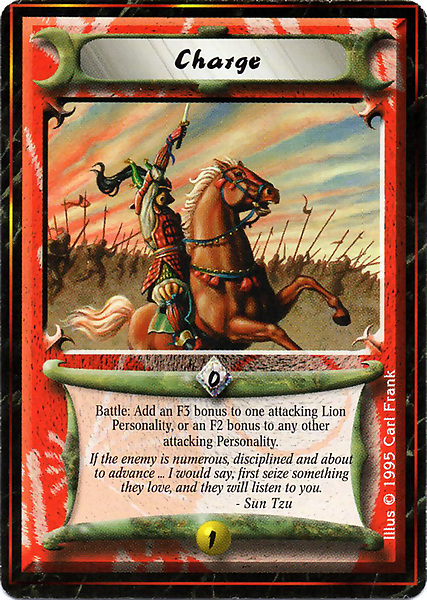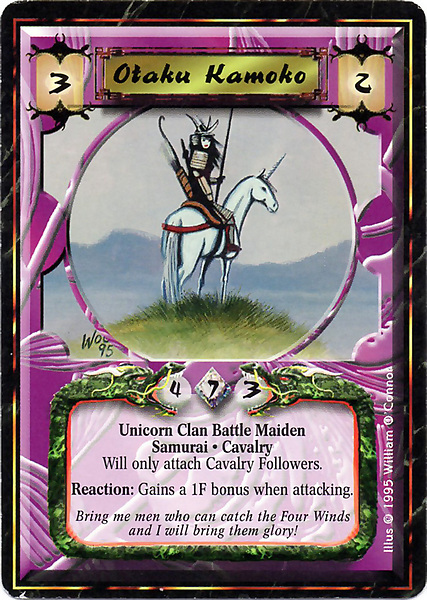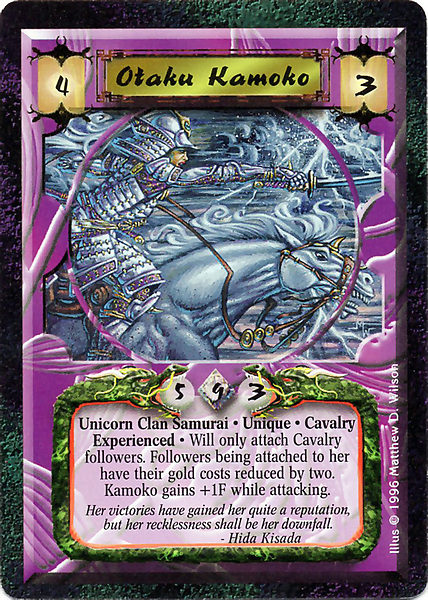The clans of Rokugan are at war. The young Emperor Hantei The 39th sits on the throne, his father killed by the Scorpion Clan Champion in a failed coup. Bayushi Shoji, the leader of the Scorpion, assassinated Hantei the 38th, believing a prophecy that the last Hantei would doom all of Rokugan. The Great Clans of Rokugan clash openly over power, territory, and standing. The ancient Naga have begun to stir in their slumber. Unbeknownst to most of the empire, a Black Scroll – the scrolls that contain the soul of the evil Kami Fu Leng – has been opened, and evil begins to creep across Rokugan.
This was the setting of Legend of the Five Rings in 1995, when the game was first released. With Fantasy Flight Games releasing their new, living card game, Legend of the Five Rings: The Card Game at GenCon this year, I thought I might go back and purposefully confuse people talk about the old CCG. L5R (old) was one of the most enduring CCGs, being in continuous production from 1995 to 2005. It had a robust and loyal fanbase, and introduce many mechanics to CCGs that were innovative at the time, and remain present in many other games today.

When first produced in 1995, there were six playable clans. The Crab are the traditional defenders of Rokugan, manning a great wall which sets Rokugan apart from the Shadowlands. In game, they are a very defensive-first faction. The Crane are a clan of courtiers and duelists, and have vast wealth which they use to pay for their armies. The mysterious Dragon are reclusive, and sometimes only spoken of in whispers, and are a clan always on the path to enlightenment. The Lion, the Emperor’s Right Hand, are a military-first clan. They are deadly honourable warriors, with the best armies in all of Rokugan. The Phoenix are a clan of wizards, and use their spellpower to bolster their armies. Lastly, the Unicorn are the Empire’s calvary, and focus on mobility and movement to win fights.
It’s a good idea to pause here to talk about one of the things that set L5R apart from other games. The game’s story progressed as sets came out. A lot of games do this now, but to my knowledge, L5R was the first game to do so. Tournaments would have story prizes – winners would get to help craft the upcoming stories, which were, in turn, reflected in cards. Because of the always progressing story in L5R, more factions were quickly introduced. Within the first few expansions, players could field decks of Naga, the ancient snake people who defended Rokugan against the Shadowlands, the dishonored Scorpion clan, Toturi’s Army, a group of ronin, The Shadowlands Horde, Yoritomo’s Alliance – a loose alliance of minor clans, or The Brotherhood of Shinsei – pacifist monks who seek enlightenment.
As the game progressed some of these clans – The Scorpion, Shadowlands, and Yoritomo’s Alliance – became major playable factions, while others withered away. Still more factions – ninja, ratlings, spirits, minor clans – were added and subtracted as the game moved along. Most factions had a specific focus to them – the Crane were excellent at dueling, while the Scorpion were deceitful, and could win by dishonouring their opponent.
Legend of the Five Rings (L5R) was also quite innovative in that it presented multiple paths to victory. You could win through a military, honour, or enlightenment victory. Military tends to be the most common victory – you win by destroying all of your opponents’ provinces. Honour victory occurs when you start your turn with forty or more family honour. Enlightenment tended to be the most difficult path to victory – you win immediately upon playing your fifth of the five rings. As the game progressed more paths to victory were opened up through specific card effects – a number of Events presented alternative win conditions that you could build a deck around.
The game was also innovative for having not one, but two, decks. Players built a Dynasty and a Fate deck. Your Dynasty deck featured the physical assets of your clan: your Holdings, the Personalities who had sworn fealty to you, and the Regions you control. It also contained Events – the one-time events that changed the course of Rokugan’s history. Your Fate deck contains the Followers, Items, Ancestors, and Spells that can attach to your Personalities, along with the Rings you can play, and, importantly, Action cards that let you, um, take actions. Constructing a Fate deck that worked cohesively with your Dynasty deck was very critical to the game.
At the start of the game, you place the top four cards from your Dynasty deck face down to represent your provinces, and you draw the top five cards of your Fate deck into your hand. Your turn starts with your straighten phase – any of your bowed cards unbow. Your events phase begins, and you turn over the cards in your province one-by-one, resolving events as they happen. You then move to the heart of the game – the action phase. In your action phase, you can attach equipment and followers to your personalities, you might send one of your personalities off to lobby for the Imperial Favour, or you might use your courtiers to influence the court.
The heart of the game is the attack phase. In the attack phase you may send your armies to march on any of your opponent’s provinces. After you assign your attackers, your opponent responds by assigning defenders. Your goal is to have total force – from your personalities, followers, items, and actions you may play – to be higher than your opponent’s force. If it is, you destroy all the cards in your opponent’s army. If your total force is higher than your opponent’s total force plus the strength of their province, you destroy the province. It is, of course, frequently never that simple: during battles you can play actions, make formations, lay terrain – all sorts of opportunities to make your army stronger than your opponent’s.
Sometimes during an attack (and rarely at other times of the game) you may have the opportunity to duel an opposing personality. Dueling is one of my favourite parts of L5R and I can’t really think of another card game that has a similar mechanic (although there certainly could be one out there). In a duel your samurai’s compare chi – their personal internal strength. Players go back and forth focusing cards until somebody calls “strike!” To focus, you take a card from your hand and place it face down on the table. When “strike!” is called, all focus cards are revealed, and their focus value – found in the little circle on the bottom of the card – is added to your personality’s chi. A type of fog of war develops – what did your opponent focus? Do you have enough strength to win the duel? Should you risk striking now, or focus again? It also forces the player to think about cards in their hand. Generally speaking, the more dramatic the game effect, the higher the focus value. So, should I focus a good card to try to keep my personality alive and kill yours, or, should I let my personality die so I can use a good card later in the battle?
After all your battling is done, you enter the last phase of your turn: the Dynasty phase. In your dynasty phase, you have the opportunity to bring the cards in your provinces into play. This is a good opportunity to talk about the “experience” system in L5R – something which has shown up in plenty of other CCGs, but originated here. Many of the personalities in L5R had deep storylines, and to reflect this in the card game, they received “experienced” versions. An experienced version could lay overtop of an inexperienced version, reflecting the growth of the personality. They tended to have slightly better stats, but, critically, they also kept the actions of their inexperienced version. This was always, to me, always attracted me to L5R – it made the game seem much more deep and involved, story wise.
L5R was in continual production from 1995 to 2005. One of the things that kept people interested in the game was the importance of the story to the game. While some of the storylines were weaker than others, having a twenty year history of fiction that was closely entwined with the game made it so very interesting. The game had a rich history, multiple paths to victory, and multiple factions each with their own strengths and weaknesses – this is something that’s hard to argue with.


***
Can I still play Legend of the Five Rings? Yes. A quick search of eBay finds plenty of sealed and opened L5R, and I’ve seen L5R in many of the FLGSs I’ve visited. The catch, though, is that through the 20+ year history of the game, there were slight variations and fluctuations with the rules, so it’s possible that not all the editions mix seamlessly with other editions. That said, if you pick up some sealed decks from the same set, you’ll be fine. L5R was very popular for many years. I would think that if you have a card game community at your FLGS, there’s probably somebody there with a collection of L5R on a shelf somewhere, and they’d be chuffed to teach you the game. Seriously, if you’re interested, ask around your community. I bet you can learn the game for free from some old greybeard CCGer.
Who Should Play Legend of the Five Rings? People who like games that work just as well with 2 players as they do with 3 or 4. People who like games with multiple paths to victory. If you like samurai in your games, especially if you like samurai with a little touch of fantasy, this is a game to check out.
Who Shouldn’t Play Legend of the Five Rings? One of the biggest turn-offs of L5R is the all-or-nothing in battles. If you lose a battle, you lose your entire army there, and it can be crippling. Losing many of your personalities may be something you’ll never recover from. If you like games where there’s (almost) always a chance for a bounce-back, L5R may not be for you. L5R also suffers from “high-powered expansion syndrome” – many of the later expansions were much more powerful than earlier iterations of the game.
Comments
No comments yet! Be the first!